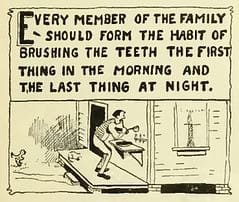- A short trip from outhouses to overconsumption — and how we ended up here.
- Industrial Roots: When Machines Changed the Game
- Post-War Boom: The Rise of Disposable Culture
- It was a time of:
- Modern Media and the Pressure to Consume
- Why These Habits Matter for the Climate
- The Good News: Habits Were Made—They Can Be Unmade
- Join the Conversation
- Come by The Goat’s Pen Forum and share your thoughts.
Where Do Our 21st Century Habits Come From?

A short trip from outhouses to overconsumption — and how we ended up here.
We like to think our modern way of life is a result of progress. And in many ways, it is.
Refrigerators keep our food fresh, lights flick on with the push of a button, and most of us haven’t had to chop firewood to stay warm.
But for all the convenience, some of our 21st-century habits are tangled up with pollution, climate change, and waste.
So, where did these habits come from? And when did ordinary living start damaging the very systems we depend on?
Let’s take a walk through history.
Industrial Roots: When Machines Changed the Game
In the late 1700s and early 1800s, the Industrial Revolution introduced coal-fired factories, mass production, and a new relationship with energy.
Before that, people lived with seasonal rhythms and relied mostly on what was local and renewable—sunlight, muscle power, wood. You couldn’t afford to waste much.
But coal changed everything. It made energy portable and abundant (for some). Cities boomed, and habits like commuting, overworking, and living far from your food source became normal for the first time.
Post-War Boom: The Rise of Disposable Culture
Flash forward to the mid-20th century. After World War II, countries like the U.S. and Canada were ready for comfort, stability, and a sense of control.
Industries scaled up. Plastic took off. Fast food chains and frozen dinners became symbols of progress. Marketing told us that more was better, and faster was best.
It was a time of:
- Planned obsolescence—designing products to be thrown away.
- Cheap energy—fossil fuels were affordable and everywhere.
- Suburban sprawl—long commutes, big lawns, and car dependency.
- Environmental impact? Barely part of the conversation.
Modern Media and the Pressure to Consume
By the 1980s and 1990s, television and advertising had shaped a global culture of aspirational living: new kitchens, cars, and outfits for every season.
Fast fashion exploded. Convenience was king. Meanwhile, the behind-the-scenes cost—resource depletion, factory pollution, rising emissions was largely invisible to consumers.
Even into the 2000s, the internet and e-commerce supercharged this mindset. With a few clicks, we could buy something we didn’t need, shipped from the other side of the world.
Why These Habits Matter for the Climate
Many of our daily habits, commuting solo by car, eating red meat at every meal, and buying more than we use, are part of systems built on fossil fuels and excess.
Heating, cooling, and powering large homes Using plastic packaging for nearly everything Wasting food in a system that overproduces Choosing speed and convenience over durability
They’re not individual failings — they’re learned behaviours. Passed down and reinforced by culture, technology, and policy.
The Good News: Habits Were Made—They Can Be Unmade
Here’s the thing: if we learned these behaviors, we can learn new ones.
If earlier generations adapted to washing machines and frozen peas, we can adapt to induction stoves and bulk bins. Climate-friendly habits aren’t about giving things up. They’re about reworking what we value, and how we show up in the world.
It helps to remember that many of our most harmful habits are relatively new. Convenience, overuse, and disposability. They’ve only been dominant for a few decades. History tells us we’ve changed before. We can change again.
And we don’t have to do it alone.
Join the Conversation
What habits do you think we’ve inherited that don’t serve us anymore?
What changes have you already made? What’s been hardest?
Come by The Goat’s Pen Forum and share your thoughts.
Because progress doesn’t mean more stuff. It means building something better, together.
